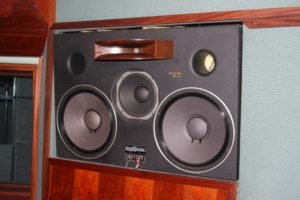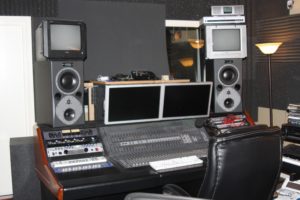Different Sounds
As I go into many project and full studios, it is always amazing to me how different each control room sounds. Each engineer has selected what he or she thinks will produce the desired sound when it comes to equipment and especially the speakers. Engineers will keep using the same monitor that they have been using even though a newer monitor may bring different variables to the monitored sounds and perform better.
All Sizes And Shapes
I see many shapes and sizes in different control rooms. In full time studios, we see both large and small monitors. In project studios, we mostly see smaller monitors. There is also, mostly in full time studios, a smaller speaker that is designed to sound like speakers found in computers, radios, and other common listening devices. The thinking is that this quality level and speaker size is what a large segment of the marketplace listen to music on.

Classical Recordings
The classical recording process is different. The classical recording process uses very small speakers, namely headphones. Headphones are used because they provide the detail necessary to monitor the sounds. They also provide isolation from outside noise. If monitors are employed, they are larger ones that represent a higher quality sound level. The classical recording artists and engineers focus on the producing a classical sound in the recordings, so electronic signal manipulation is frowned upon.
Acoustical Pallet
Each speaker or monitor produces a different color if you will upon our acoustic palette. The engineer will choose this or that monitor that will create the sound the engineer wants to produce and would be considered by the engineer to be good sound. The engineer must create sounds with a big picture in mind. He or she must fit the electronic pieces together to form a larger picture.
Mid Range Music
The music is always found in the mid ranges. It is that middle frequency range where our vocals lie. It is the area where layers and layers of sound are stacked upon each other and all must be able to be heard. A speaker must be able to produce this middle range energy and do it in a manner that will create an emotional connection between the music and the listener. It is even welcome to select a monitor that has more of a forward sounding mid range.
No Standardization
All of this subjectivity and impression creating, lends itself to a lack of standardization in the recording, especially monitoring process. Most engineers do not care about how a monitor works but rather really only care about that monitor working for them and helping them to create their sound. In a playback mode, they want to not hear all the little sounds that took to make the recording but rather the sum of all of these parts to produce a musically sounding piece of work.
Hi- Fi Everything
The hi-fi person wants to hear everything. Hi-fi people want a speaker to be revealing and produce resolution and detail. Hi-fi people want to hear all of the parts. The recording engineer just wants to hear the music, not all the parts. Each uses a speaker to accomplish what each one considers to be good sound. It is all about what each person wants to hear and that want is based on many different variables.
Manufacturers Part Of Problem
All of this subjectivity, enters into decisions manufacturers make. Manufacturers do not assist in the sound quality producing process. They will design a loudspeaker to fit into a particular price point or even appearance point. Sound quality may be a sixth or seventh priority in the total loudspeaker design considerations. Marketing and saleability overrides sound quality.
Room Sound / Speaker Sound
How the speaker sounds in the room is another variable. Near field monitoring will only do so much to eliminate the room sound. The room is always in the mix and must be adjusted for. Fighting a bad room can only add more noise and confusion to our mixes, especially in the low end. Rooms and speakers need to be sized matched in order to avoid room distortions. Large drivers in small rooms goes against both common and acoustical sense.
Recording Standards
There needs to be a better definition of what a good recorded sound is. When I play back any recorded music within my listening room, I am always grabbing for a knob on my EQ at the listening position. Every recording has some acoustic abnormality that needs to be addressed. The issues are usually focused on the low end of the recorded source. There is usually a need to reduce through EQ some part of the low end frequency response , so that the low frequency energy produced by the speakers from the recording will fit into the room.
THX Equipment Requirements
THX uses this standardization process to apply to the speakers and amplifiers that they want to produce their source data. They require that amplifiers have a particular or minimum power handling capacity to be able to cover large transient ranges from gun shots to explosions. Speakers reproducing the THX format must have a full range frequency response handling capacity and match the amplifier power ratings. This certification process specifies the necessary performance minimums of the equipment but does not really do anything about what the room sounds like.
Standardization Need
We need some type of acoustic standardization for our sound engineers to follow. We need to raise the minimum performance levels and standards of our recording engineers, so that we are all at least starting from a similar page. I am thankful that there are always engineers who have read farther into the acoustic book. Their recordings really do sound good.






